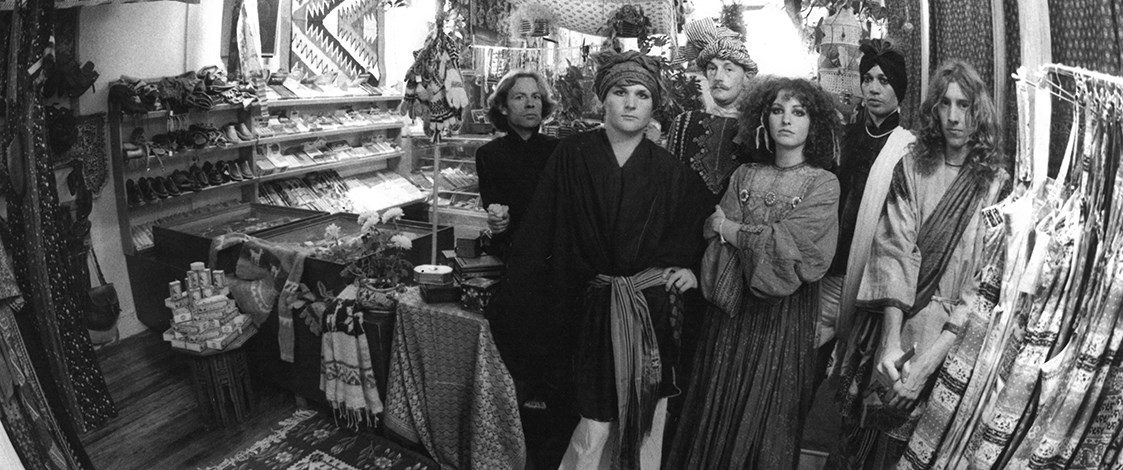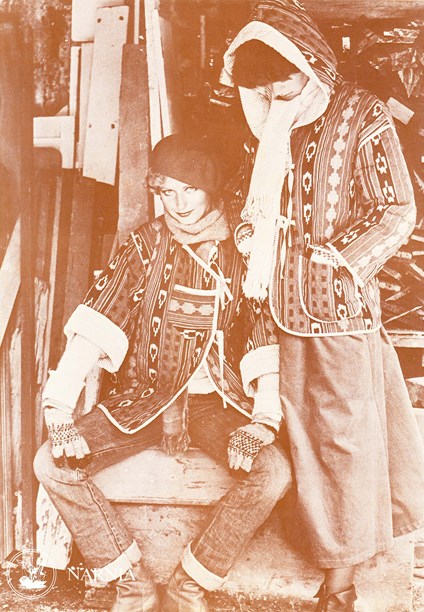Stories
The Merchant Adventurers of Narnia
1971-1988

At the beginning of the 1970s, young people all over the world were challenging the status quo and looking for alternative lifestyles. Artists and designers were exploring co-operative ways of working, challenging the dominance of high-end labels and manufacturers. The Merchant Adventurers of Narnia were university students when they began making clothes and accessories to sell at the local craft market, but it was their experiences travelling through Asia that helped them carve out their own unique path.
The original Merchant Adventurers, David (Doc) White and Prince Rupert Kurghan (formerly Dave McLatchie), were university students in Wellington when they met at a party. They found they had something in common - they had both managed to avoid university holiday jobs in wool sheds or freezing works by selling garments and accessories to their friends. Doc was tie-dyeing t-shirts and Rupert was making suede bags when they decided to work together on the venture. As fans of C S Lewis’s Narnia series, they decided on The Merchant Adventurers of Narnia as the name for their business.
The suede bags, which were big enough to hold a vinyl LP, were embellished with rivets, fringing and sometimes pokerwork. Before long Rupert and Doc expanded their offering to include waistcoats and sandals, which they sold at Wellington’s Victoria and Lambton Square markets.
They soon outgrew the market stalls and found an upstairs space to rent at 154 Willis Street. It was an old house with plenty of space for a workroom and retail area where people came to hang out as well as shop. In contrast to those who wore glamorous clothing from Jane Bezar and His Lordships, Narnia (as it became known) had a clientele that identified with hippy culture. They were looking for exotic garments that exemplified unique elements of craft and customisation.

This Wellington building at 154 Willis Street was home to Narnia for more than a decade.
The breakthrough came when Rupert, who was studying history and Asian studies at university, went travelling through Afghanistan, Syria, Nepal, India and Turkey. Rupert’s flatmate Zeke Alley recalls that he came back and spread an array of treasures in the lounge of their flat. "He brought home brass plates and trays from India, a sitar, Tibetan boots from Kathmandu, a sheepskin coat from Afghanistan and inlaid wooden boxes from Damascus," Zeke recalls. "New Zealand had tight import restrictions at the time and we had never seen anything like this." Rupert introduced some of these objects to the shop where they quickly sold out. "It was the first store of its kind in Wellington," Doc explains, "and it was surprisingly successful".
It wasn’t part of their initial plans, but overseas travel and imports were to play a big part in the future of Narnia. By now Rupert and Doc were working full time for the business. Inspired by a similar shop they found in Oxford Street in Sydney, Narnia was filled with a huge range of clothing, fabric, dhurrie rugs, bedspreads, incense, smoking paraphernalia, basketware, cane furniture, carpets, musical instruments and a range of decorative items from Asia. Whenever they could afford it, Rupert and Doc travelled to Asia to bring back goods to sell in Narnia.
The business was still small when Rupert’s flatmate Zeke left to travel overseas in 1973. "My wife Judy and I planned to set off on the classic hippie trail, overland through South East Asia and India to London," Zeke recalls. Rupert and Doc, who were in touch with Zeke and Judy during their trip, saw an opportunity to access more stock from Afghanistan. "Despite our total lack of business experience, we accepted the responsibility and were sent instructions by mail to Kabul. We packed koochi dresses and kurta that were worn by the local people with fabric, embroidered panels and handicrafts and sent them back to New Zealand." Although the clothes didn’t make it past the strict custom officers of the time, the fabric and handicrafts arrived in Wellington in steel trunks.
Delighted with the shipment, Rupert and Doc asked Zeke if he’d like to join them in the business. Zeke returned to New Zealand where he, and later a fourth partner Wayne Sampson, became one of the owners of Narnia.
The owners of Narnia - Doc, Rupert, Zeke and Wayne. Images © Narnia Archives..
They became experts at working with the complex import restrictions in 1970s New Zealand. Fabric could be imported as long as it had a raw edge, but clothing imports were limited to those who had a licence. Embroidered pieces also didn’t need a licence. Over the years they imported Indian rayon, Chinese embossed jacquard lining, and "astoundingly cheap" embroidered panels from Afghanistan.
Narnia designs from the mid 1970s. Images © Narnia Archives.
A lot of these fabrics were made up into garments that were sold in the Narnia shop. Mary Anne Douglas, a dressmaker from Wellington, supervised a team of outworkers. From the beginning Narnia clothes were made in styles that people would wear in their everyday lives. It was the unique fabrics and great designs that made them outstanding.
Towards the end of 1974 they opened two Narnia stores in Auckland. Located in His Majesty’s Arcade, off Queen Street, one store focused on clothing, while the other sold dress fabrics, homewares and decorative items. In 1977 they opened another store in Manchester Street in Christchurch.
The Narnia store in Christchurch. Images © Narnia Archives.
As well as their own stores, Narnia clothes were sold in retail outlets across New Zealand. This expansion was made possible through their relationship with Rod Larnach, a commercial traveller who had an in-depth knowledge of the fashion retail market. In the mid 1970s Rod spotted a range of Laura Ashley-style prints that Narnia had imported from India. He said to the owners, "Give me samples of four dress styles made up in a range of these fabrics and I’ll show you what the rag trade is all about." Rod returned with a large number of orders. As demand increased Narnia contracted the making of the garments to clothing factories.
A newsletter advertising fabrics, garments, homeware and smoking paraphernalia, 1976. Images © Narnia Archives.
In 1977 when Mary Anne moved to Dunedin, they employed a Wellington Polytech graduate, Sarah Kedgley, to design the Narnia ranges. Sarah had worked in the apparel industry in London, and had travelled through Afghanistan and India. She was a perfect fit with the Narnia aesthetic.

Jackets modelled by the Narnia designer Sarah Kedgley (left) and Jan McEwen. Images © Narnia Archives.
In the early 1980s, Narnia started attending the Fashion Fairs in Auckland, which were organised by Bruce Goldsworthy from the Auckland Manufacturer’s Association. Each manufacturer would set up in a hotel room as a showroom where they were visited by prospective retailers. These fairs generated a lot of new business for Narnia.

Narnia's room at the Auckland Fashion Fair in the early 1980s. Image © Narnia Archives.
Wholesaling proved so successful for Narnia that when His Majesty’s Arcade was demolished in 1987, they decided not to re-open in Auckland. Instead they set up a warehouse in a large house in Mt Eden and moved two staff up from Wellington to wholesale to stores in the Auckland area.
Ads for Narnia from the mid 1980s. Images © Narnia Archives.
The opening up of import licences in New Zealand in the 1980s revolutionised the business. While many fashion labels struggled to compete, Narnia utilised their contacts all over Asia and within six months they were no longer making any garments in New Zealand. Sarah Kedgley now spent half her time overseas, sourcing fabrics and working with factories to make their clothes.

Ad for Narnia's three boutiques in Auckland, Wellington and Christchurch. Image © Narnia Archives.
Around the same time several of the Narnia owners were keen to step back from the business and enjoy more time with their families. They formed a public company with a friend and were ready to list on the stock exchange when the market crashed. While they continued trading through this time, in the end the company was put into receivership. "We walked away with our houses and that was it," Zeke says.
The Merchant Adventurers of Narnia had captured and ridden high on the free spirit of their time but when the neoliberal agenda imposed itself on New Zealand society this particular adventure ended.
Text by Kelly Dix. Image of the staff and friends of the Christchurch Narnia boutique. Image © Narnia Archives.
Published August 2020.